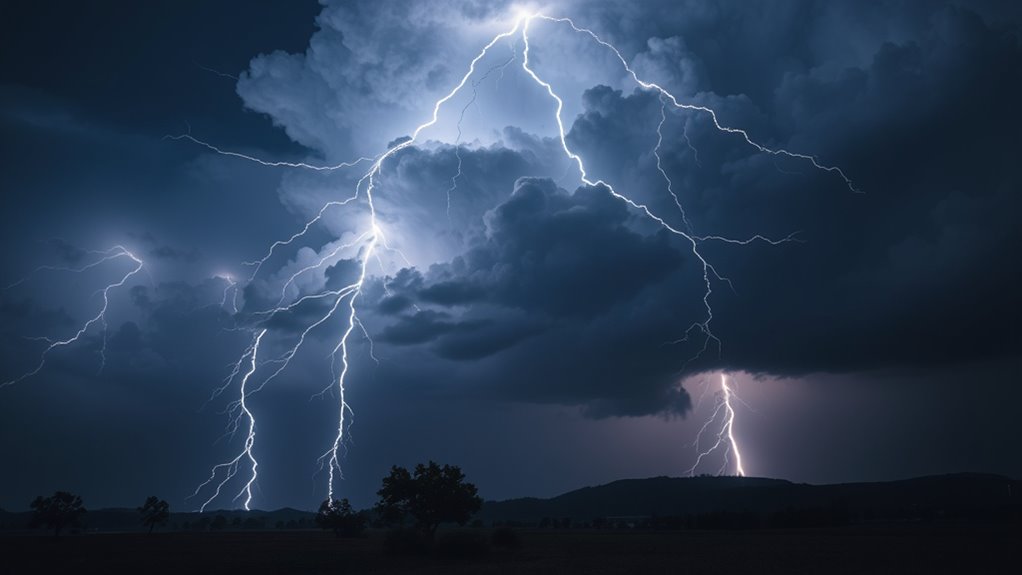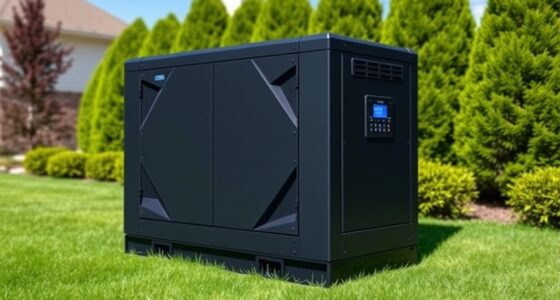Lightning is a sudden, intense electrical discharge during storms that can damage your home’s electronics and wiring. Power surges happen when voltage spikes, often caused by lightning strikes or large appliances switching on and off. Protecting your home involves installing surge protectors, grounding systems, and unplugging sensitive devices during storms. If you want to keep your electrical system safe and learn simple safety tips, there’s more to discover for your peace of mind.
Key Takeaways
- Lightning is a powerful electrical discharge during storms that can damage electronics and infrastructure.
- Power surges are sudden voltage spikes often caused by lightning or large appliances switching on and off.
- Installing surge protectors and ensuring proper grounding helps prevent damage from surges and lightning strikes.
- Signs of damage include flickering lights, non-working outlets, sparks, and burning smells.
- Regular maintenance, testing, and replacing surge protectors are essential for ongoing electrical safety.
What Is Lightning and How Does It Happen?

Lightning is a sudden, powerful discharge of electricity that occurs during thunderstorms. It often happens as a result of static electricity building up in clouds. When the electrical charge in a cloud becomes too strong, it seeks to equalize by releasing energy. This release typically occurs as a cloud-to-ground strike, where electricity leaps from the cloud to the Earth’s surface. You can think of it as nature’s way of balancing out the static electricity created by colliding particles within the storm cloud. The bright flash you see is the lightning bolt itself, a rapid movement of electrons. These events happen incredibly fast, but they release immense energy, making lightning one of the most dramatic displays of natural electrical discharge. Additionally, the high energy levels involved can cause damage to electronic devices and infrastructure if not properly protected.
Understanding Power Surges and Their Causes
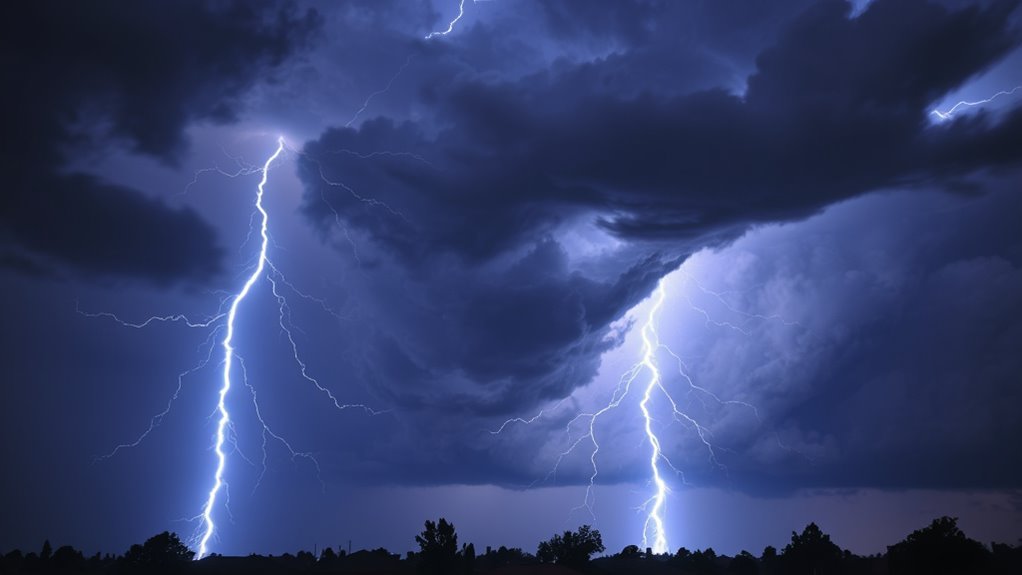
Power surges are sudden increases in electrical voltage that can damage appliances and disrupt your home’s electrical system. They often occur when there’s a sudden change in power flow, such as during a lightning strike or when large appliances turn on or off. Proper grounding systems help direct excess voltage safely into the ground, reducing the risk of damage. Surge suppression devices protect your electronics by absorbing or blocking excess voltage before it reaches your outlets. Understanding how power surges happen enables you to take proactive steps to safeguard your home. Even minor surges can wear down devices over time, so investing in good surge suppression is essential. Being aware of these causes helps you better prepare and protect your valuable appliances. Regular maintenance of grounding systems can significantly reduce the likelihood of damage from unexpected surges.
The Risks of Lightning Strikes and Power Surges to Your Home

While your home may seem safe, a lightning strike or power surge can strike unexpectedly, posing serious risks to your electrical system and appliances. Lightning safety is vital because a direct strike can cause fires, damage electronics, or even disable your home’s wiring. Power surges from lightning can also:
Lightning strikes and power surges can unexpectedly damage your home’s wiring and electronics.
- Fry sensitive electronics like computers and TVs
- Damage your home’s wiring and electrical panel
- Increase the risk of fire hazards
- Shorten the lifespan of appliances
To protect yourself, use surge prevention techniques such as installing surge protectors, unplugging devices during storms, and grounding your electrical system properly. Being proactive helps minimize damage and keeps your home safe during thunderstorms. Remember, understanding these risks is the first step toward safeguarding your household. Additionally, choosing best laundry detergents with protective features can help keep your appliances in good condition after a surge.
Recognizing Signs of Surge Damage
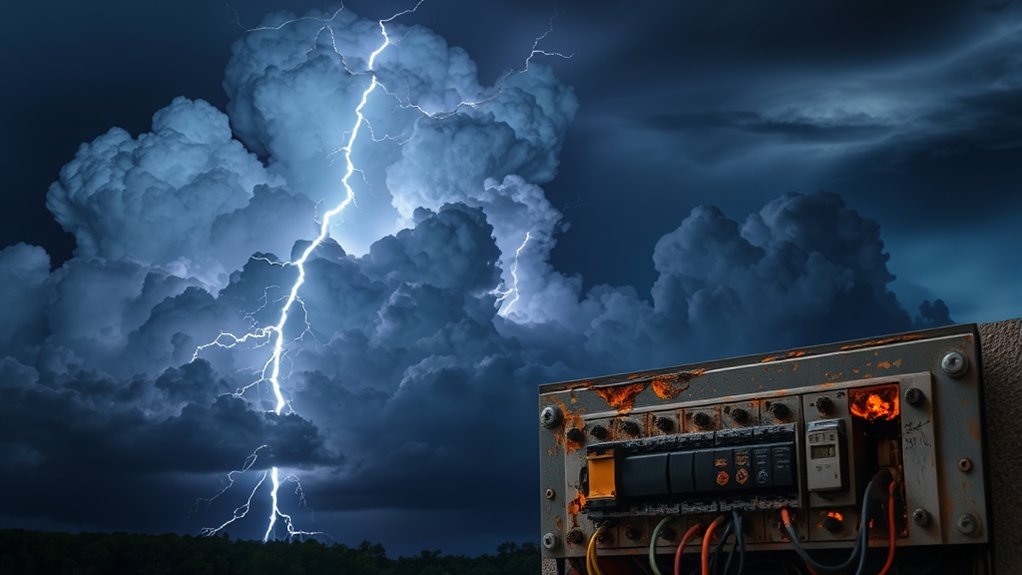
Detecting surge damage early can save your appliances and prevent further electrical issues. Look for signs during electrical inspections, such as flickering lights, outlets that don’t work, or appliances that suddenly stop functioning. Surge damage can be subtle, so stay alert. Here’s a quick guide:
| Symptom | Possible Cause | Action |
|---|---|---|
| Flickering lights | Power fluctuation | Schedule electrical inspection |
| Non-working outlets | Surge damage | Replace or repair wiring |
| Burning smell or sparks | Severe surge damage | Turn off power and call a professional |
Recognizing these signs helps you catch issues early and prevent costly repairs. Regular inspections can identify surge damage before it affects your entire system. Incorporating advanced detection tools can further enhance early warning capabilities.
Simple Ways to Protect Your Home From Lightning and Surges
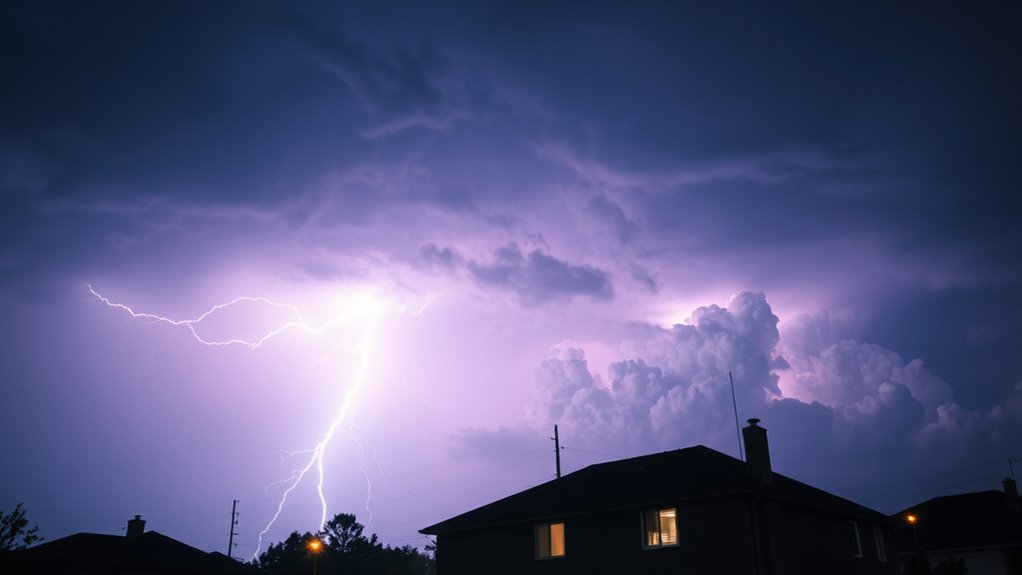
Protecting your home from lightning and surges is easier than you might think. Installing surge protectors, unplugging devices during storms, and ensuring proper grounding can make a big difference. These simple steps can help keep your electronics safe and your home secure. Additionally, using sustainable materials in your home’s electrical system can enhance overall safety and efficiency.
Install Surge Protectors
Installing surge protectors is one of the most effective ways to shield your home from lightning strikes and power surges. Choosing the right surge protector types is essential, and they work best when connected to proper grounding systems. Here’s how to maximize protection:
- Select a surge protector designed for your devices and electrical system.
- Ensure it’s installed at the main electrical panel for whole-house coverage.
- Use surge protectors with built-in grounding connections to safely redirect excess energy.
- Regularly check and replace surge protectors to maintain their effectiveness.
- Remember that proper support hours can help you get expert assistance for installing and maintaining your surge protection system.
Unplug Devices During Storms
While surge protectors help reduce the risk of damage during storms, unplugging devices adds an extra layer of safety. During severe weather, lightning strikes can cause power surges that damage electronics or start fires. To improve your storm safety and emergency preparedness, make it a habit to disconnect all unnecessary devices, especially sensitive electronics like computers, TVs, and chargers. This simple step prevents power surges from traveling through outlets and reaching your devices. Keep in mind, storms can be unpredictable, so unplugging should be part of your overall storm safety plan. Additionally, using Vetted electric bike conversion kits ensures your outdoor equipment remains safe and reliable even in storm-prone conditions. By taking this proactive step, you minimize the risk of damage and ensure your home and belongings are better protected during electrical surges caused by lightning or other storm-related events.
Use Proper Grounding Methods
Using proper grounding methods is one of the most effective ways to safeguard your home from lightning strikes and power surges. Proper grounding helps direct excess electricity safely into the earth, reducing damage. To confirm your grounding techniques are effective, consider these steps:
- Install a grounding rod directly into the soil outside your home.
- Use grounding wires that meet electrical codes and connect all your surge protectors to the grounding system.
- Check that your main electrical panel has a proper grounding connection.
- Regularly inspect grounding connections for corrosion or looseness.
- Ensuring your home’s electrical system includes home furnishings that meet safety standards can also help protect against electrical issues.
Installing Surge Protectors: What You Need to Know

To effectively protect your electronic devices from power surges, it is vital to understand how to install surge protectors correctly. First, choose high-quality surge suppressors designed for your needs, ensuring they can handle the expected surge levels. Always plug surge protectors directly into grounded outlets; a proper ground fault connection is essential for them to work effectively. Avoid daisy-chaining multiple surge protectors, as this can reduce their effectiveness. Once installed, test your surge protector regularly and replace it if it has absorbed a significant surge or shows signs of wear. Proper grounding and safety considerations are critical to ensuring your surge protector functions correctly. Remember, surge protectors are an important line of defense, but they only work properly if installed correctly and grounded properly, helping to shield your valuable electronics from unexpected power spikes.
Tips for Maintaining Electrical Safety During Storms

Storms can cause power surges and outages that threaten your electrical safety. To stay protected, consider these tips:
- Keep up with electrical code updates to ensure your wiring and outlets meet current safety standards.
- Create a storm preparedness plan that includes unplugging sensitive electronics before storms arrive.
- Use surge protectors on essential devices to prevent damage during electrical fluctuations.
- Regularly inspect your home’s wiring and grounding systems, especially after severe storms, to catch potential hazards early.
- Be aware of Vetted – Grobal World information on electrical safety and proper maintenance to further protect your home during storm events.
Frequently Asked Questions
Can Lightning Strikes Damage Electronic Devices Indoors?
Yes, lightning strikes can damage your electronic devices indoors. To guarantee lightning safety and indoor protection, unplug devices during storms or use surge protectors. Lightning can cause power surges that travel through wiring and damage electronics even if the strike doesn’t hit your house directly. By taking these precautions, you minimize the risk of costly damage and keep your devices safe during thunderstorms.
How Do Lightning Rods Prevent Home Damage?
Imagine a bolt of lightning roaring down from the sky, craving a path to earth. Your lightning rod acts like a vigilant guard, guiding that energy safely through grounding systems, preventing it from sparking inside your home. If you have a metal roofing, it can work alongside the rod, providing an added shield. Together, they redirect dangerous surges away from your electronics, keeping your home safe and intact.
Are There Specific Surge Protectors for Outdoor Appliances?
Yes, there are specific surge protectors designed for outdoor appliances. You should look for outdoor surge protectors or weatherproof surge devices that are built to withstand the elements. These devices feature rugged enclosures and waterproof ratings, ensuring they protect your outdoor equipment from power surges caused by lightning or electrical spikes. Installing these surge protectors helps prevent damage and keeps your outdoor appliances safe during storms or power fluctuations.
What Is the Average Cost to Repair Surge Damage?
Imagine your home’s electronics as a row of dominoes; a surge can topple them all. On average, repair expenses for surge damage range from $200 to $800, depending on the extent of the damage and the appliances affected. Cost estimates can vary widely, so it’s smart to have surge protectors in place. Protecting your devices now can save you money and headaches down the line.
Does Insurance Cover Lightning and Surge-Related Damages?
Yes, your insurance may cover lightning and surge-related damages, but coverage limits vary. You should file insurance claims promptly after a storm, and review your policy to understand any coverage limitations. Some policies include specific exclusions or caps for surge damage, so it’s important to verify your policy details or speak with your insurer. Taking these steps ensures you know what’s covered and helps you get the compensation you deserve.
Conclusion
Understanding lightning and surges helps you protect your home effectively. While some believe surge protectors completely prevent damage, they greatly reduce risks but aren’t foolproof. Staying vigilant during storms and maintaining your equipment is key. By following simple safety tips, you can minimize the chances of costly damage. Remember, being prepared and informed makes a real difference—so trust in your knowledge and take action to keep your home safe during lightning season.
